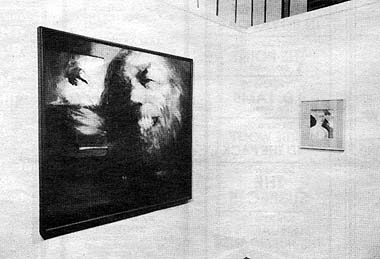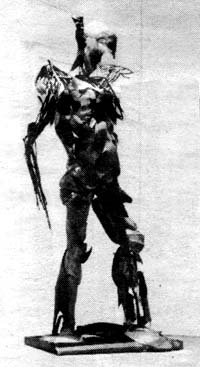Apocalypse
Michigan Gallery
2661 MichIgan Ave., Detroit
Through July 4, 1987
And I looked,
and behold a pale horse:and his name that sat on him was Death.
and Hell followed with him.
( New Testament,
Book of Revelatlon; Chapter 6)

It is hardly surprising that the
biblical prophecy of apocalypse in the form of four horsemen who
will bring war, conquest, famine and death to the world is a theme
that concerns a great many artists. The theme has produced great art
(Durer’s 15th-cenuty woodcuts for example) and not a few pictorial
disasters.
When Detroit sculptor Sergio De Gusti chose the title ‘Apocalypse”
for the current exhibition at the Michigan Gallery which he curated,
he was not interested in blatant sensationalism. "The last
thing I was looking for, he explained, “was a series of paintings
with bombs going off.
"What I wanted was to bring
together a group of local artists who I know personally and whose
work I respect— artists with a particular orientation toward
fantastic and surrealistic images who sensitively explore the moral
and spiritual issues of this theme in our time within the framework
of skill.” said De Glusti. The project was about nine months in
the making, and De Glusti has succeeded— admirably. He has
assembled a selection of mixed-media work by 25 outstanding local
artists, both the well-known and the up-and-coming, to create an
exhibit that has a subtle, psychological, melancholic and sometimes
humorous content, rather than one with a visceral explosion of blood
and gore, or an overly sermonizing religious message.
 |
|
Untitled by Jack Baily
(left); "Subconcious Holyland" by Carl Demeulnaere. |
The one work that does deal
directly with war Is a chilling but almost unbearably moving
painting by Michael Joseph, aptly titled Class of 1965,” where
soldiers in modern combat dress in the top half are massed with
photographs of Joseph’s 172 high school graduation classmates.
Joseph, who attended an all-male Jesuit school, has made markings in
colored pencil on the boyish faces of those killed and wounded in
action in Vietnam— 33 killed and eight wounded.
Coyote-like dogs tear at a piece of meat In an auto graveyard,
oblivious to the single female observer in one of Edward Levine’s
powerful “dog paintings.” Equally powerful Is Mel Rosas’ Il
Medico de Ia Peste”: a Venetian street bordered by a canal of
sickly, green water, deserted but for the menacing, hooded and
masked (with a huge beaked nose) plague doctor who seeks out the
dying and the dead.
Jo Powers, whose work is always fraught with unknown tension, paints
a pristine-new freeway devoid of traffic and activity, except for a
young woman with a madonna-like face crawling up the bank- like a
shot from a Fellini movie. The unmistakable mystique of a Bradley
Jones painting is depicted with two stony-faced guys in a car, the
one In the passenger seat nonchalantly drinking from a can of pop
while cleaning his gun.
 |
|
(Left)
"Yellow River" by James Stephens; (right) Untitled
by Jack Baily. |
Talented newcomer James Stephens
conjures up a vision of hell with an unpeopled, desolate Junkyard,
where the still-smoking chimney stacks give the Impression of an
incinerator belching poisonous waste or even a Nazi gas chamber.
Turning to surrealism and symbolism, David Becker’s two
meticulously detailed drawings and small watercolor with their
macabre and humorous figures and phallic symbols evoke Images of a
20th-centuiy Hieyonimus Bosch. Ed Fraga is represented by one of his
extraordinary avant-garde paintings that often seem to blend
mysticism and eroticism with religious symbolism, Russell Keeter
with a stylish “theatrical-backdrop” painting which might be
compared to a medieval brothel in hell and Douglas Bulka with two
apocalyptically symbolic paintings.
Jack Bailey’s view of a world destined for disintegration reflects
haunting, Francis Bacon-like imagery, and another standout is a
surrealistic painting, with an agonized, ghostly face as the focal
point, by up-and-coming young artist Tom Humes.
There are fewer sculptures in the exhibit than paintings, but these
are remarkable in their diversity of style.
 |
|
Sculpture by
Jay Holland |
Jay Holland has two magnificent lifesize statues representing man as the broken hero. A figurative
bronze relief
of the first horseman of the first
horsemen of the apocalypse by
John Pappas combines fluid of movement with an Interesting patina, and
David Barr contributes a beautifully crafted sled-like model and a
drawing from his "Bering Straits" series. Barr wants to
build two
sculptures and ship them to villages on either
side of the Bearing Straits, the two settlements where the Soviet
Union and America geographically almost meet. Barr said he is
concerned about global issues and believes art can help to unify
humanity. Who knows? It is possible that a glasnost gesture of this
kind might discourage possible future disputes over oil and
territory in that region, and help prevent events that could lead to
apocalypse.
Down in the vaults of the Michigan Gallery's basement, Ed Fraga has
a sculpture/installation that comes close to a surrealistic shrine.
The focal point here is a luminous photographic transparency of a
robed woman, but so strangely apparition-like is this figure that
"she" also appears to suggest an androgynous form. A
Christ figure?
By comparison, the black-lined walls of
another basement room, highlighting a ghoulishly beautiful
photograph by Misha Gordin, look like the setting for a black mass.
This head of a man, emerging from a hole in the ground, resembles a
disembodied piece of Greco/Roman statuary weeping tears of blood. (Gordin,
who seems to have an unlimited supply of volunteer models,
apparently covered a male face with plaster or glaze to achieve the
slightly cracke effect.)
Italian-born De Gusti, who is well known for his romantic,
renaissance sculptures, is, rather surprisingly, represented in the
exhibit by a large and stunning abstract charcoal drawing in black
and gray, which he titles “Diluvio” and which summons up an
image of the flood or the last wave that might well engulf the
world.
De Giusti explained that he was reluctant to feature any one artist
in the Introductory poster and flyer. “How could I possibly choose
the Work of a single artist,” he said, “when they are all so
good?” Instead, he photographed and used two awesome segments of
bronze tombstones on the apocalypse theme from the Cimitero
Monumentale In Milan, Italy, one by G. Piazza, dated 1910. Other
fine photographic imagery is by Kevin Sharp, Mary Aro and Dan
Pohlman.
“Apocalypse” is a testament of the excellent art being made in
Detroit
See “Apocalypse” now - and save Kathleen
Rashid's diptych painting for the finale - an eerie view on one
panel of a city which seems about to fall, and a television screen
picturing Katherine
Hepburn and Humphrey Bogart on the other which someone has forgotten
to switch off Understated, but psychologically menacing! The
Michigan Gallery has earned many kudos for mounting good shows by
Detroit-area artists, and this Is one of the best.
Manon
Meilgaard is a frequent contributor to the Metro
Times on the local art scene.
Photos by Bob Mckeown
|